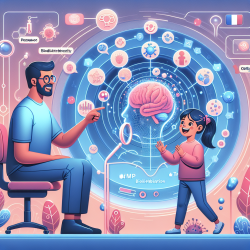Introduction
In the dynamic field of speech-language pathology, the integration of technology and collaborative approaches is essential for improving outcomes, particularly for children. Drawing insights from the research article "Transforming and extending library services by embracing technology and collaborations: A case study," this blog explores how practitioners can enhance their skills and services by embracing these strategies.
The Power of Technology in Therapy
Technology has revolutionized various sectors, and speech-language pathology is no exception. The article highlights how technological advancements have expanded library services, which can be paralleled in therapeutic practices. By leveraging technology, practitioners can offer more engaging and effective therapy sessions. This includes utilizing online platforms for remote therapy, which can increase accessibility for children in diverse locations.
Collaboration: A Key to Success
Collaboration with technology experts and other professionals is crucial. The case study underscores the importance of partnerships in extending services. For speech-language pathologists, collaborating with IT specialists can lead to the development of innovative tools tailored to specific therapeutic needs. Additionally, working with educators and parents can ensure a holistic approach to a child's development.
Implementing Data-Driven Practices
The research emphasizes the importance of data-driven decisions. In speech-language pathology, collecting and analyzing data from therapy sessions can provide insights into a child's progress and areas needing improvement. By adopting a data-centric approach, practitioners can tailor interventions more precisely, leading to better outcomes.
Challenges and Opportunities
While technology and collaboration offer numerous benefits, they also present challenges. Ensuring data privacy and security is paramount, especially when dealing with sensitive information about children. Additionally, practitioners must stay abreast of technological advancements to effectively integrate them into their practice.
Encouraging Further Research
As technology continues to evolve, ongoing research is necessary to identify new opportunities for enhancing therapy. Practitioners are encouraged to engage in research initiatives, either by conducting their own studies or by staying informed about the latest findings in the field.
Conclusion
By embracing technology and fostering collaborations, speech-language pathologists can significantly enhance their practice and improve outcomes for children. These strategies, informed by research, provide a framework for innovation and excellence in therapy.
To read the original research paper, please follow this link: Transforming and extending library services by embracing technology and collaborations: A case study.










